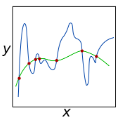Conventionally, the matrix completion (MC) model aims to recover a matrix from partially observed elements. Accurate recovery necessarily requires a regularization encoding priors of the unknown matrix/signal properly. However, encoding the priors accurately for the complex natural signal is difficult, and even then, the model might not generalize well outside the particular matrix type. This work combines adaptive and implicit low-rank regularization that captures the prior dynamically according to the current recovered matrix. Furthermore, we aim to answer the question: how does adaptive regularization affect implicit regularization? We utilize neural networks to represent Adaptive and Implicit Regularization and named the proposed model \textit{AIR-Net}. Theoretical analyses show that the adaptive part of the AIR-Net enhances implicit regularization. In addition, the adaptive regularizer vanishes at the end, thus can avoid saturation issues. Numerical experiments for various data demonstrate the effectiveness of AIR-Net, especially when the locations of missing elements are not randomly chosen. With complete flexibility to select neural networks for matrix representation, AIR-Net can be extended to solve more general inverse problems.
翻译:在《公约》方面,矩阵完成模式(MC)旨在从部分观测到的元素中恢复矩阵。准确的恢复必然需要一个未知矩阵/信号的正规化编码前缀。然而,精确地为复杂的自然信号编码前缀是困难的,即便如此,模型也可能无法在特定的矩阵类型之外进行广泛化。这项工作结合了适应性和隐含的低级别正规化,根据当前回收的矩阵,以动态方式捕捉先前的常规化。此外,我们的目标是解答问题:适应性正规化如何影响隐性正规化?我们利用神经网络代表适应性和隐性常规化,并命名了拟议的模型 \ textit{AIR-Net}。理论分析表明,AIR-Net的适应性部分加强了隐性正规化。此外,适应性正规化器在终端上消失,从而可以避免饱和问题。各种数据的量化实验显示了AIR-网络的有效性,特别是当缺失元素的位置不是随机选择时。在选择矩阵代表的神经网络时,AIR-Net可以完全灵活地扩展到更普遍地解决问题。





